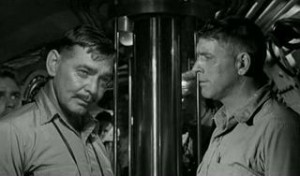Bledsoe and a momentarily lucid Richardson unite to go after the elusive “Akikaze,” but they are up against a real nemesis. As Richardson has said, “The ‘Akikaze’ never misses.”
A tight and well-paced film at ninety-three minutes, the focal point is the charisma between the two officers, actually the well-tooled animosity and resentment, mainly on Bledsoe’s part since he is the one demoted by Richardson. Bledsoe’s tight-jawed demeanor—a favorite Lancaster mannerism—has the larger hurdle in coming to respect his chief; Richardson, on the other hand, seems to have liked Bledsoe from their first meeting, impervious to his resentment and calling him “Jim.”
 The tension in the characters on screen can possibly be attributed to the unscripted animosity on the set. Lancaster, always the tireless professional, was annoyed by Gable’s abrupt departure from the set at five o’clock each day, even in the middle of scenes. Not to detract from Gable, who was equally the professional and always prepared when he came to work, the older actor wanted to get home to his wife Kay.
The tension in the characters on screen can possibly be attributed to the unscripted animosity on the set. Lancaster, always the tireless professional, was annoyed by Gable’s abrupt departure from the set at five o’clock each day, even in the middle of scenes. Not to detract from Gable, who was equally the professional and always prepared when he came to work, the older actor wanted to get home to his wife Kay.
Run Silent Run Deep is directed by Robert Wise, who had behind him such successes as The Day the Earth Stood Still and Executive Suite and, ahead, triumphs that included West Side Story and The Sound of Music.
Nor were the other artists slouches. Cinematographer Russell Harlan had under his own belt Red River, Witness for the Prosecution, Rio Bravo and To Kill a Mockingbird. Only the last of these was among his five Oscar nominations, which also include Blackboard Jungle and Hawaii. He would never win an Oscar.
Composer Franz Waxman, who did win two Oscars—for Sunset Blvd. and A Place in the Sun—adds dark undercurrents to the naval action. This same talent is displayed in The Bride of Frankenstein, Rebecca, The Philadelphia Story and that other excellent submarine saga he scored, Destination Tokyo.
And this old man Gable, the aged screen lover? Well, in Run Silent Run Deep any challenge to that title is inconclusive. There are no women in the film, aside from the obligatory wife (Mary LaRoche) seen briefly in an early scene—and, on a sub bulkhead, a long-legged pinup in mini-shorts, whose derrière the men pat for good luck.
Perhaps on occasions Gable did hold his own with women thirty years his junior. As it’s been pointed out by others, in 1932’s Red Dust he was opposite two beauties of the day, Jean Harlow and Mary Astor. And the screen sizzled. When the film was remade twenty-one years later as Mogambo—possibly the actor’s best post-WWII film—Harlow was dead and Astor was forty-seven. That Gable was fifty-two didn’t matter: he had the same role as the great white hunter. But, now, the two ladies who were after him were Ava Gardner, 31, and Grace Kelly, 25.
And the screen sizzled.
I agree with your analysis: “The focal point is the charisma between the two officers, actually the well-tooled animosity and resentment.” That’s interesting that Gable and Lancaster didn’t get along when the movie was made. Ironically, it may have benefited the film. The younger Bledsoe is contemptuous of the older and more experienced Richardson. It is a timeless theme that the younger generation often thinks it knows more than the older generation. I wrote a short post on Run Silent Run Deep called “Honor vs Dishonor.” Here is the link if you would like to read it: https://christopherjohnlindsay.wordpress.com/2015/10/04/run-silent-run-deep/